Saudi Arabian Army
The Saudi Arabian Army, officially the Royal Saudi Land Forces (Arabic: القُوَّاتُ البَرِّيَّةُ المَلَكِيَّة السُّعُودِيَّة, romanized: Al-Quwwat al-Bariyah al-Malakiyah as-Su'udiyah), is the principle land warfare branch of the Armed Forces of Saudi Arabia. It is part of the Saudi Ministry of Defense, which is one of the two military departments of the government of Saudi Arabia, together with the Ministry of National Guard.[3]
| Royal Saudi Land Forces | |
|---|---|
| القوات البرية الملكية السعودية | |
 Emblem of the Royal Saudi Land Forces | |
| Founded | 1744 de facto January 13, 1902 de jure [1] |
| Country | Saudi Arabia |
| Branch | Army |
| Type | Land forces |
| Role | Ground-based warfare |
| Size | 75,000[2] |
| Part of | Armed Forces |
| Garrison/HQ | Ministry Of Defense |
| Motto(s) | "الله أكبر" God is the greatest |
| Anniversaries | 13 January; 121 years ago |
| Equipment | List of equipment |
| Engagements | List of wars |
| Decorations | |
| Website | www |
| Commanders | |
| Current commander | Lt. Gen. Fahd Al-Mutair |
| Notable commanders | Faisal of Saudi Arabia Abdulaziz of Saudi Arabia Turki bin Abdullah Al Saud (1755–1834) Abdulaziz bin Muhammad Al Saud Faisal al-Duwaish Sultan bin Bajad Al Otaibi Sultan bin Abdulaziz |
| Insignia | |
| Flag | 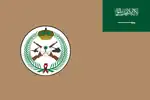 |
| War flag |  |
History
.JPEG.webp)
The modern Army of Arabia has its roots in the Saudi state, which was dating to 1744,[1] and is considered to be the birth year of the Saudi army. As of 1901 the ground forces was re-established as a separate branch of the armed forces with the starting of the modern Saudi state. and it is considered the oldest branches of the Saudi Arabia's military.[4]
Historically, the MoW was created to unify the armies of the state under one military power. It was existed until 1933, when it was renamed "Agency of Defence" under the Finance Minister administration as Agent. By 1944, the Agency was developed (MoD) and incorporated into the Armed Forces Inspectorate.[5][6]
Other events that led to an expansion of the Saudi Army were the Arab–Israeli conflict in 1948, the fall of Shah Mohammad Reza Pahlavi in the Iranian Revolution in 1979 and the subsequent fears of possible hostile's actions, and as well as the Gulf War in 1990. In the year 2000, Saudi Arabia's government spent billions of dollars to expand the Saudi military including the Army. The current minister of defense is Prince Mohammad bin Salman, who was appointed on 23 January 2015.[7]
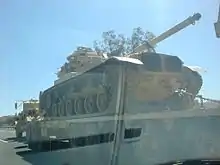
Wars involved

- Wars of Najed (1744–88)
- Saudi–Mamluk War (1790–1811)
- Ottoman–Saudi War (1811–18)
- Saudi Civil War (1865–75)
- Ottoman campaign II (1870–71)
- Battle of Arwa (1883)
- Battle of Mulayda (1891)
- Battle of Riyadh III
- Battle of Dilam (1903)
- Saudi–Rashidi War (1903–07)
- Battle of Hadia (1910)
- Battle of al-Kut (1913)
- Battle of Jarrab (1915)
- Battle of Kinzaan (1915)
- Saudi–Hashemite War (1918–19)
- Kuwait-Saudi War (1919–20)
- Battle of Hail (1921)
- Saudi-Transjordan War (1922)
- Battle of Hejaz II (1924–25)
- Ikhwan Revolt (1927–30)
- Mutawakkilite War (1934)
- 1948 Arab–Israeli War more than 3,000 Saudi troops participated in combat against Israel.
- 1967 RSLF deployed over 20,000 troops in Jordan.
- 1969 Al-Wadiah War. South Yemeni Forces invaded Al-Wadiah, a Saudi town, but later were defeated by the Saudi Army.[8][9]
- 1973 during the Yom Kippur War, Saudi Arabia airlifted a light armoured battalion of Panhard AML-90s and 3,000 troops to Syria four days after the conflict began.[10] The force participated in a number of relatively minor clashes with the IDF between October 16-19, mostly in concert with the Jordanian 40th Armored Brigade.[11]
- 1979 Grand Mosque seizure. The Saudi army and SANG, together with Pakistani and French commandoes, reclaimed the mosque from extremist insurgents.
- Gulf War (1990–91) Together with the allied forces, the Saudi army and SANG played a major part in the Battle of Khafji and the Liberation of Kuwait.
- 2007–10 Houthi Insurgency. Yemeni Houthis attacked southern Saudi Arabia and were defeated by the Saudi army.
- 2015 Saudi Arabian-led intervention in Yemen at the request of the Yemeni president to repel Houthi rebels allied with the deposed Ali Abdullah Saleh, as part of the Yemeni Civil War (2015–present).
Structure
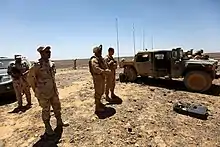
The combat strength of the Saudi Army consists of four armoured, five mechanized, two light infantry brigades, one airborne brigade, the Al-Saif Al-Ajrab guard brigade, the Saudi Royal Guard Regiment (three battalions), three helicopter groups, and three artillery brigades.[12] In 2004, it was reported that the RSLF deployed "..the 12th Armoured Brigade and 6th Mechanized Brigade at King Faisal Military City in the Tabuk area. It deployed the 4th Armoured Brigade, and 11th Mechanized Brigade at King Abdul Aziz Military City in the Khamis Mushayt area. It deploy[ed] the 20th Mechanized Brigade and 8th Mechanized Brigade at King Khalid Military City near Hafr al Batin. The 10th Mechanized Brigade is deploy[ed] at Sharawrah, which is near the border with Yemen and about 150 kilometers from Zamak."[13]
Despite the addition of a number of units and increased mobility achieved during the 1970s and 1980s, the army's personnel complement has expanded only moderately since a major buildup was launched in the late 1960s. The army has been chronically understrength, in the case of some units by an estimated 30 to 50 percent. These shortages have been aggravated by a relaxed policy that permitted considerable absenteeism and by a serious problem of retaining experienced technicians and noncommissioned officers (NCOs). The continued existence of the separate Saudi Arabian National Guard also limits the pool of potential army recruits.[3]
Armor
- 4th (King Khaled) Armoured Brigade
- 6th (King Fah'd) Armoured Brigade
- 7th (Prince Sultan) Armoured Brigade
- 8th (King Fah'd) Armoured Brigade
- 10th (King Faisal) Armoured Brigade
- 12th (Khalid ibn al-Walid) Armoured Brigade
A typical Saudi armoured brigade has an armoured reconnaissance company, three tank battalions with 35 tanks each, a mechanized infantry battalion with AIFVs/APCs, and an artillery battalion with 18 self-propelled guns. It also has an army aviation company, an engineer company, a logistic battalion, a field workshop, and a medical company.[14]
Mechanized
- 11th Mechanized Brigade
- 12th Mechanized Brigade
- 13th Mechanized Brigade
- 14th Mechanized Brigade
- 20th Mechanized Brigade
A typical Saudi mechanized brigade has an armoured reconnaissance company, one tank battalion with 40 tanks, three mechanized infantry battalions with AIFVs/APCs, and an artillery battalion with 18 self-propelled guns. It also has an army aviation company, an engineer company, a logistic battalion, a field workshop, and a medical company. It has 24 anti-tank guided weapons launchers and four mortar sections with a total of eight 81 mm (3 in) mortars.[14]
Infantry
- 16th (King Saud) Light motorized infantry brigade
- 17th (Abu Bakr al-Siddiq) Light motorized infantry brigade
- 18th (King Abdullah) Light motorized infantry brigade
- 19th (Umar ibn Al-Khattab) Light motorized infantry brigade
Each infantry brigade consists of three motorized battalions, an artillery battalion, and a support battalion. Army brigades should not be confused with Saudi Arabian National Guard brigades.
Airborne Units and Special Security Forces
- The 1st Airborne Brigade
- 4th Airborne Battalion
- 5th Airborne Battalion
- 64th Special Forces Brigade
- 85th Special Forces Battalion
The Airborne Brigade is normally deployed near Tabuk. The Airborne Brigade has two parachute battalions and three Special Forces companies. Saudi Arabia is expanding its Special Forces and improving their equipment and training to help deal with the threat of terrorism. The Special Forces have been turned into independent fighting units to help deal with terrorists, and report directly to Prince Sultan.
Artillery Battalions
- five artillery battalions
Aviation
- 1st Aviation Group
- 2nd Aviation Group
- 3rd Aviation Group
- 4th Aviation Group
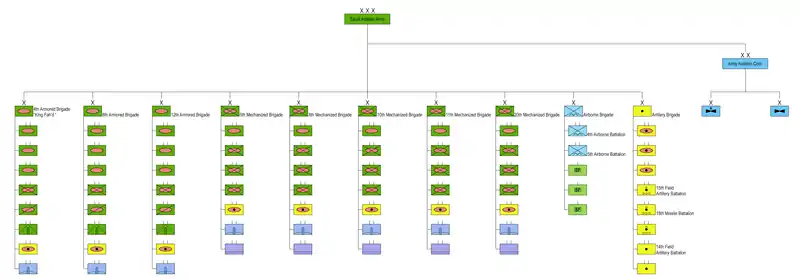
Ranks
RSLF officer
| Rank group | General / flag officers | Senior officers | Junior officers | Officer cadet | ||||||||||||||||||||||||||||||||
|---|---|---|---|---|---|---|---|---|---|---|---|---|---|---|---|---|---|---|---|---|---|---|---|---|---|---|---|---|---|---|---|---|---|---|---|---|
 |
 |
 |
 |
 |
 |
 |
 |
 |
 |
 | ||||||||||||||||||||||||||
| فريق أول Fariq 'awal |
فريق Fariq |
لواء Liwa |
عميد Amid |
عقيد Aqid |
مقدم Muqaddam |
رائد Ra'id |
نقيب Naqib |
ملازم أول Mulazim awwal |
ملازم Mulazim |
مرشح Murashah | ||||||||||||||||||||||||||
RSLF enlisted
| Junior enlisted | Non-commissioned officers (NCOs) | Warrant officers (WOs) | ||||||||||
|---|---|---|---|---|---|---|---|---|---|---|---|---|
| Private (Pte) |
First class private (Pfc) |
Corporal (Cpl) |
Vice sergeant (VSgt) |
Sergeant (Sgt) |
Staff sergeant (SSgt) |
Warrant officer (WO) | ||||||
| E-1/2 | E-3 | E-4 | E-5/6 | E-7 | E-8 | E-9 | ||||||
| No chevron (Arabic: جندي Jundi) |
One chevron (Arabic: جندي أول Jundi Awaal) |
Two chevrons (Arabic: عريف Areef) |
Three chevrons (Arabic: وكيل رقيب Wakil Raqib) |
Four chevrons (Arabic: رقيب Raqib) |
Four chevrons with stripe (Arabic: رقيب أول Raqib Awaal) |
stripe (Arabic: رئيس رقباء Rais Ruquba) | ||||||
Equipment
See also
References
- Historical Dictionary of Saudi Arabia (15 March 2020). Historical Dictionary of Saudi Arabia. Rowman & Littlefield. p. 480. ISBN 9781538119808. Archived from the original on 14 February 2023. Retrieved 29 June 2020.
- IISS (2021). The Military Balance 2021. Routledge. p. 363. ISBN 978-1-032-01227-8.
- Global Security 2006.
- Wynbrandt, James (2004). A Brief History of Saudi Arabia (1st ed.). p. 353. ISBN 9781438108308. Archived from the original on August 8, 2017. Retrieved October 10, 2016.
- Lebkicher, Roy (1952). The Arabia of Ibn Saud. R.F. Moore Company. Archived from the original on 2023-02-14. Retrieved 2020-09-12.
- "Middle East: Saudi Arabia". The World Factbook. Langley, Virginia: Central Intelligence Agency. 17 October 2018. Archived from the original on 19 March 2021. Retrieved 21 October 2018.
- "The $2 Trillion Project to Get Saudi Arabia's Economy Off Oil". Bloomberg News. Archived from the original on 2016-10-15. Retrieved 2017-06-22.
- Vassiliev, Alexei (March 2013). King Faisal: Personality, Faith and Times - Alexei Vassiliev - Google Książki. ISBN 9780863567612. Archived from the original on 2023-02-14. Retrieved 2020-10-20.
- Halliday, Fred (2002). Revolution and Foreign Policy: The Case of South Yemen, 1967-1987. Cambridge University Press. p. 160. ISBN 9780521891646. Archived from the original on 2023-02-14. Retrieved 2020-04-09.
- O'Ballance 1979, pp. 28–370.
- Asher, Dani (2014). Inside Israel's Northern Command: The Yom Kippur War on the Syrian Border. Lexington: University Press of Kentucky. pp. 415–418. ISBN 978-0813167374.
- IISS 2022, p. 366.
- Cordesman & Obaid 2004, p. 50.
- "Accéder Google Francais".
- "الرتب" [Ranks]. rslf.gov.sa (in Arabic). Saudi Arabian Army. Archived from the original on 22 October 2017.
- Cordesman, Anthony H.; Obaid, Nawaf (September 13, 2004). "Saudi National Security: Military and Security Services Challenges & Developments".
- Global Security (2006). "Royal Saudi Land Forces". www.globalsecurity.org. Archived from the original on 2015-10-29. Retrieved 2006-12-09.
- IISS (2022). The Military Balance 2022. London: Routledge for the International Institute for Strategic Studies.
- O'Ballance, Edgar (1979). No victor, no vanquished: The Yom Kippur War (1979 ed.). Barrie & Jenkins Publishing. ISBN 978-0-214-20670-2.
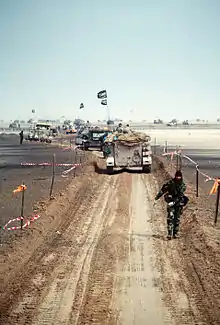
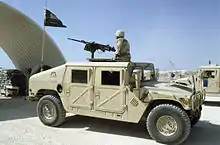
.svg.png.webp)